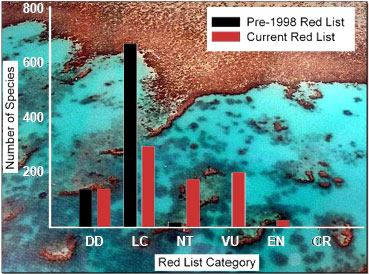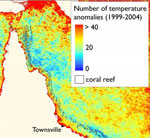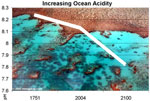1/3 of corals face extinction
1/3 of corals face extinction
mongabay.com
July 10, 2008
|
|
Nearly one-third of reef-building corals are vulnerable to extinction, according to an assessment of 845 species of coral. Rising temperatures, increased incidence of disease, and human disturbance are driving the trend.
Assessing the conservation status of corals from around the world using IUCN Red List Criteria, an international team of researchers found that 32.8 percent of reef-building corals are in categories with elevated risk of extinction. At greatest risk are corals in the Caribbean and the Coral Triangle of the Western Pacific.
“Our results emphasize the widespread plight of coral reefs and the urgent need to enact conservation measures,” wrote the authors.
 Comparison of current Red List Categories for all reef-building coral species to hypothetical Red List Categories back-cast to pre-1998. (CR=Critically Endangered, EN=Endangered, VU=Vulnerable, NT=Near Threatened, LC=Least Concern, DD=Data Deficient). |
Corals are besieged by threats at local and global scales. Local threats — which primarily result from human disturbance — include coastal development, sedimentation resulting from erosion and deforestation, sewage discharges, nutrient loading and eutrophication from agricultural run-off, coral mining and overcollection for the pet trade, over fishing, and recreational activities. On a global scale, reefs are imperiled by rising temperatures, which cause bleaching or the expulsion of symbiotic algae that provide corals with sustenance, and ocean acidification, which causes changes in reef communities by making it more difficult for some corals to form carbonate skeletons that serve as their structural basis. These synergetic effects cause physiological stress, weakening corals and leaving them susceptible to infection by pathogens, including bacteria and viruses.
The authors say the results show that the extinction risk of corals has increased dramatically over the past decade, from 13 in threatened categories before 1998 to 231 today. The number of “near-threatened” species rose from 20 to 176 over the same period. The proportion of threatened coral species is second only to amphibians — which are also susceptible to climate change — among animal groups.
The researchers warn that without immediate conservation efforts, a large proportion of coral species may go the way of the dinosaurs, resulting in significant biodiversity loss and economic impacts.
“If corals cannot adapt, the cascading effects of the functional loss of reef ecosystems will threaten the geologic structure of reefs and their coastal protection function, and have huge economic effects on food security for hundreds of millions of people dependent on reef fish. Our consensus view is that the loss of reef ecosystems would lead to large-scale loss of global biodiversity,” the authors conclude.
K.E. Carpenter et al. (2008). One Third of Reef-Building Corals Face Elevated Extinction Risk From Climate Change and Local Impacts. Science 10 July 2008.
Related articles
U.S. coral reefs in trouble
(7/7/2008) Nearly half of U.S. coral reefs are in “poor” or “fair” condition according to a new study by the National Oceanic and Atmospheric Administration (NOAA).
Coral reefs declining faster than rainforests
(8/8/2007) Coral reefs in the Pacific Ocean are dying faster than previously thought due to costal development, climate change, and disease, reports a study published Wednesday in the online journal PLoS One. Nearly 600 square miles of reef have disappeared per year since the late 1960s, a rate twice that of tropical rainforest loss.
 |
Global warming is killing coral reefs
(5/7/2007) A new study provides further evidence that climate change is adversely affecting coral reefs. While previous studies have linked higher ocean temperatures to coral bleaching events, the new research, published in PLoS Biology, found that climate change may increasing the incidence of disease in Great Barrier Reef corals. Omniously, the research also shows that healthy reefs, with the highest density of corals, are hit the hardest by disease.
 |
Some corals may survive acidification caused by rising CO2 levels
(3/29/2007) Several studies have shown that increased atmospheric carbon dioxide levels are acidifying the world’s oceans. This is significant for coral reefs because acidification strips carbonate ions from seawater, making it more difficult for corals to build the calcium carbonate skeletons that serve as their structural basis. Research has shown that many species of coral, as well as other marine microorganisms, fare quite poorly under the increasingly acidic conditions forecast by some models. However, the news may not be bad for all types of corals. A study published in the March 30 issue of the journal Science, suggests that some corals may weather acidification better than others.
 |
Carbon dioxide levels threaten oceans regardless of global warming
(3/8/2007) Rising levels of carbon dioxide will have wide-ranging impacts on the world’s oceans regardless of climate change, reports a study published in the March 9, 2007, issue of the journal Geophysical Research Letters.
Coral reefs decimated by 2050, Great Barrier Reef’s coral 95% dead
(11/17/2005) Australia’s Great Barrier Reef could lose 95 percent of its living coral by 2050 should ocean temperatures increase by the 1.5 degrees Celsius projected by climate scientists. The startling and controversial prediction, made last year in a report commissioned by the World Worldwide Fund for Nature (WWF) and the Queensland government, is just one of the dire scenarios forecast for reefs in the near future. The degradation and possible disappearance of these ecosystems would have profound socioeconomic ramifications as well as ecological impacts says Ove Hoegh-Guldberg, head of the University of Queensland’s Centre for Marine Studies.